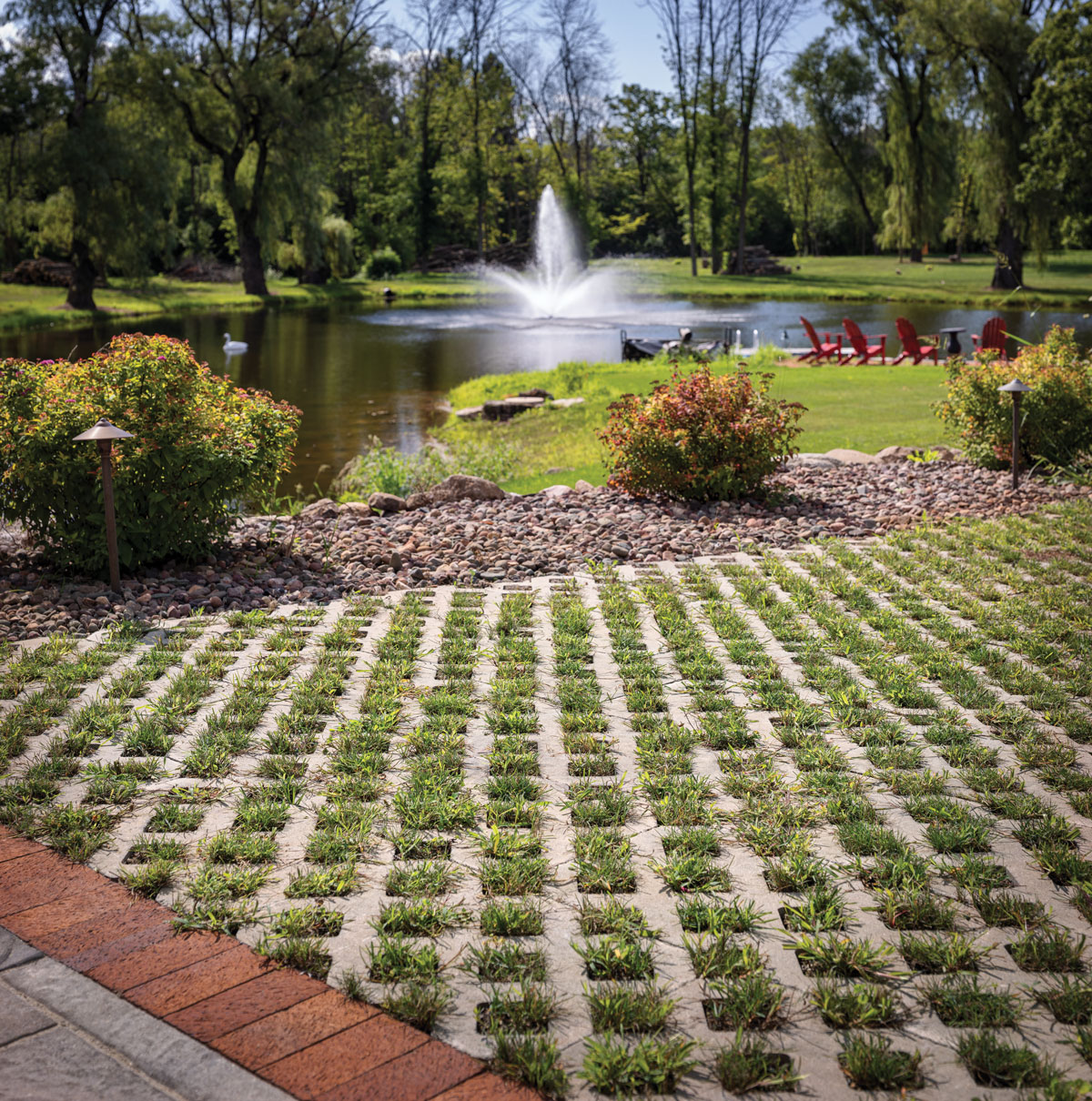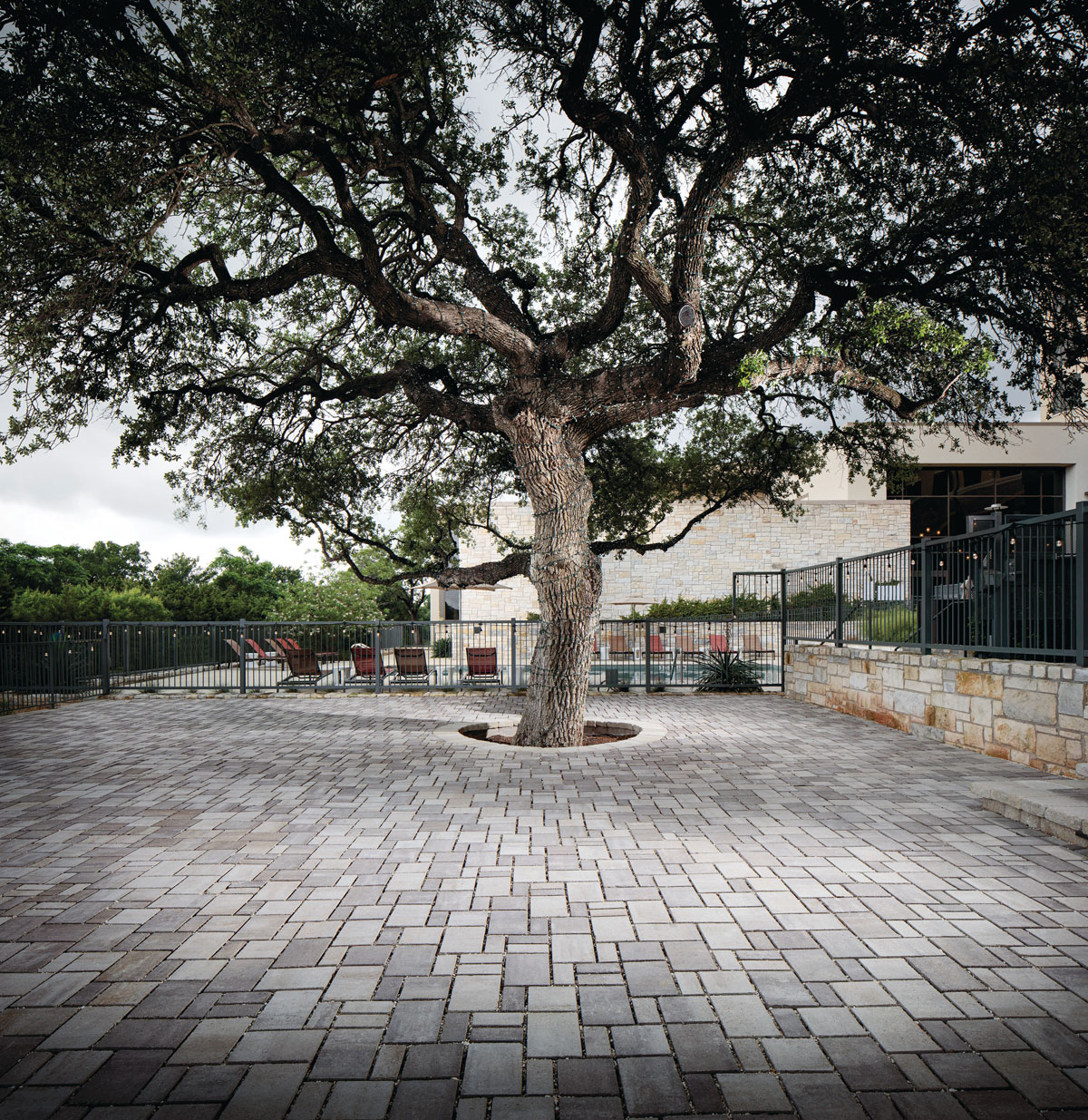
Photo courtesy of Belgard Commercial
As one of the largest unit concrete product manufacturers in North America, Oldcastle Architectural Products Group (APG) manufactures commercial retaining wall and permeable paver products as part of CRH’s Building Products division. CRH is a leading global diversified building materials group known for fabricating materials and products for the construction and maintenance of infrastructure, as well as commercial and residential applications.
Since 1995 Oldcastle’s Belgard hardscaping products have included a variety of landscaping styles that work for any project. Part of the company’s mission is to apply its extensive research and development of environmentally responsible technology and practices to create eco-friendly products. APG offers several products—including permeable pavers—that decrease a company’s environmental footprint and can contribute to earning LEED credits for rainwater and heat island mitigation.

Photo courtesy of Belgard Commercial
Why Permeable?
There are four million miles of paved roads in the US and an estimated 50% of urban surfaces that are impervious, according to the Earth Institute at Columbia University. Vast stretches of impervious pavement constrict drainage and prevent water from soaking into the ground, creating heat islands and contributing to flooding and pollution, which then contributes to biological contamination of waterways and wildlife.
Belgard permeable paver systems can be used to create green infrastructure, according to Kevin Earley, director of Commercial Belgard Pavers. They’re environmentally friendly because they mimic how nature returns rainwater to the ground. The paver systems incorporate stone aggregate underneath for drainage and storage, allowing them to function like a detention basin under the pavement. Permeable pavers are surrounded by chip gravel and feature spacer bars large enough to eliminate surface runoff during most rain events. “When it rains, water goes through the joint openings,” Earley says.
The durable permeable interlocking pavers are available in a variety of shapes, sizes, colors, and textures that provide both an aesthetic appeal and a functional advantage. Beyond the undeniable environmental rewards, there’s a safety element associated with permeable pavers. Because there’s no standing water, black ice is eliminated. This makes pavement less dangerous to traverse and further reduces the environmental impact by reducing or eliminating the need to use salt. “Salts are not good for the environment, but since meltwater drains through the joints, there’s no ice buildup, so it reduces the need to use salt,” Earley says.
Applications
You can use permeable pavers for residential and commercial driveways, walkways, parking lots, roads, and many other hardscape applications, and they tend to be most popular in regions with a lot of rain or in older cities with combined sewers. “With new regulations mandating the use of additional green infrastructure, there are incentives now to convert impervious to pervious,” Earley says.
Unlike traditional detention basins, which require significant space, these pavers are multi-purpose, providing structural support for parking and pathways as well as functioning as a stormwater control measure. Similarly, Earley says permeable pavers are simpler to maintain than detention systems because they’re easily accessible; all maintenance is performed at the surface. Routine maintenance consists of sweeping or blowing away surface debris. If clogging occurs, it’s not difficult to vacuum or replace the joint material with chip gravel. See some of Belgard’s most popular permeable concrete pavers above.

Photo courtesy of Belgard Commercial
What About Retaining Walls?
For centuries, civilizations have dry-stacked stone to build walls. This ancient technique is still used today. Oldcastle APG manufactures modular retaining wall blocks that are dry-cast interlocking concrete units placed without mortar. Designed to support a sloping face of soil, they are flexible, helping them outperform other types of walls in earthquake-prone regions because they move with the earth, according to Don Armstrong, western region regional market manager for Oldcastle. They also eliminate the need for frost depth footings in cold climates.
Oldcastle’s segmental retaining wall blocks are targeted toward three markets—retail (smaller product found at big-box stores for use by a homeowner on backyard projects), residential (mid-sized products contractors typically buy from dealers), and commercial (larger products used in conjunction with geogrid, often used for roadway projects and by large land developers).
Design flexibility is a major benefit. “It’s easy for an engineer or contractor to modify a plan on the fly if site conditions change,” Armstrong says. There are few height limitations, enhancing creative options. It’s easy to transport and inexpensive to produce on a block machine. “We can create a lot quickly; they have a high production rate.”
For the retail product, the DIY aspect is an advantage, but even with the commercial product, Armstrong says the ease of installation makes it popular with contractors. And, of course, it’s attractive as well as functional. The blocks are available in a variety of colors, sizes, shapes, and textures that can be configured to form straight or curved lines, corners or angles, and steps.


